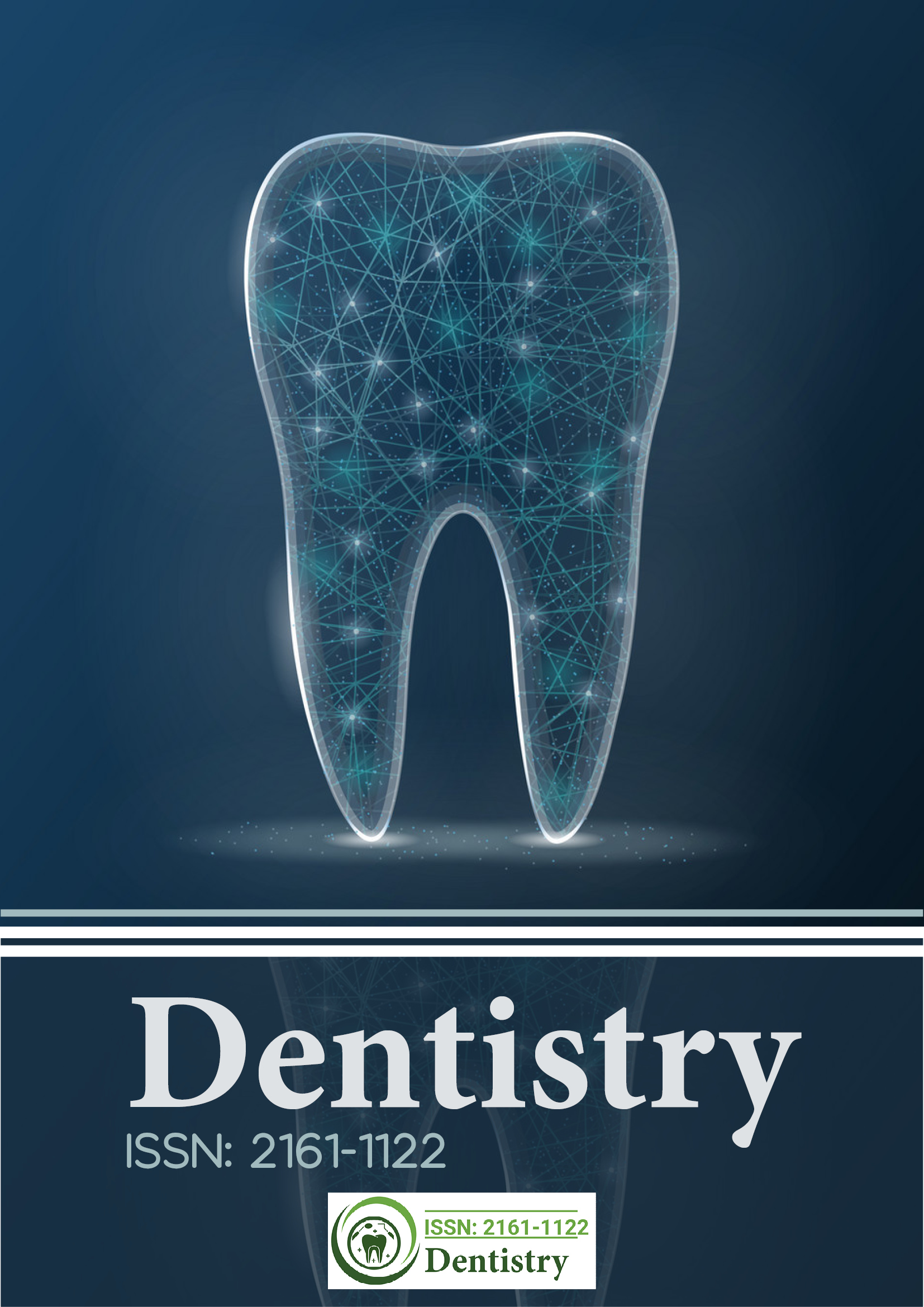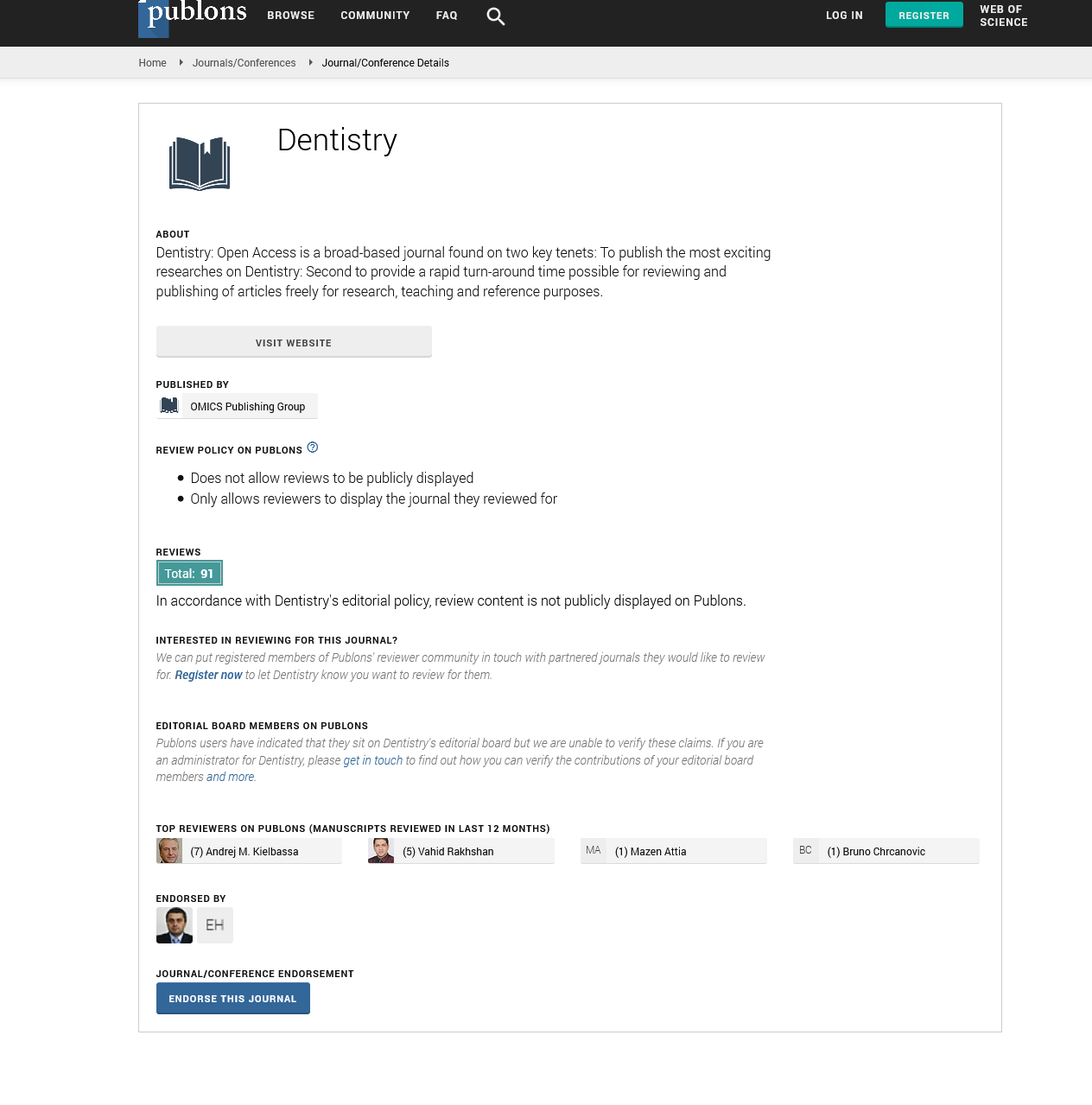Citations : 2345
Dentistry received 2345 citations as per Google Scholar report
Indexed In
- Genamics JournalSeek
- JournalTOCs
- CiteFactor
- Ulrich's Periodicals Directory
- RefSeek
- Hamdard University
- EBSCO A-Z
- Directory of Abstract Indexing for Journals
- OCLC- WorldCat
- Publons
- Geneva Foundation for Medical Education and Research
- Euro Pub
- Google Scholar
Useful Links
Share This Page
Journal Flyer

Open Access Journals
- Agri and Aquaculture
- Biochemistry
- Bioinformatics & Systems Biology
- Business & Management
- Chemistry
- Clinical Sciences
- Engineering
- Food & Nutrition
- General Science
- Genetics & Molecular Biology
- Immunology & Microbiology
- Medical Sciences
- Neuroscience & Psychology
- Nursing & Health Care
- Pharmaceutical Sciences
A coraline-derived peri-implant bone graft
3rd International Conference on Advanced Dental Education
November 15-16, 2018 | Edinburgh, Scotland
Mark C Perry and Sandra Ammonn
University of Western Ontario, Canada
Scientific Tracks Abstracts: Dentistry
Abstract:
Marine corals have been discussed as potential human bone grade substitutes since 1979. The structure of marine coral is similar to human bone. Its components, structure and property are similar to the inorganic components of human bone. Coraline hydroxyapatite???s biocompatibility is derived from the exoskeleton of the ???high content calcium carbonate scaffolds.??? Coraline hydroxyapatite is manufactured from marine coral. Marine coral has a trabecular structure similar to that of human bone. The benefits of Coraline hydroxyapatite include its biocompatability, osteoconductivity, biodegradability and safety. It avoids immune rejection that may occur with the use of allografts. Its rate of action depends on the porosity of the exoskeleton and the site of implantation. Its use as a carrier for autogenous bone grafts during oral surgical procedures including extractions, implant surgery and periodontal surgery will be presented. Coraline hydroxyapatite provides a structure and support mechanism to guide the formation of new bone. Synthesized hydroxyapatite o???ers poor porosity for the promotion of vascular and hard tissue. Coraline hydroxyapatite has a similar pore structure as human cancellous bone. Cases will be presented via video, still photography and radiography to demonstrate the use of a Coraline hydroxyapatite bone graft to aid in the repair of alveolar bone in extraction sites, implant surgical sites, cases of peri-implantations and periodontal surgery. A step-by-step guide will be exhibited so that clinicians may begin to apply this procedure in their own practice. Coraline Hydroxyapatite/Autogenous Bone Graft Procedure: 1. Collect autologous bone graft material, utilizing the Osseous Coagulum Trap, from an extraction procedure, surgical implant procedure and/or a suitable donor site. 2. Mix the Coraline hydroxyapatite graft material with the autologous bone (from the Osseous Coagulum Trap) and autologous blood. 3. Utilizing a suitable carrier place the autologous/Coraline bone graft into position in the alveolus to create a stable graft location in order that osteoconductivity may begin immediately. Ensure sutures are not under high tension, do not over-fill the alveolar cavity with the graft, and prescribe antibiotics and an anti-bacterial mouth rinse post-operatively. 4. Allow four to six months of healing to occur before determining radiographically if the implant and graft material are fully osseointegrated. There are four major features of Coraline hydroxyapatite: 1. Biocompatibility 2. Strength similar to bone. 3. Promotion of remodeling. 4. Bioactivity- it reacts and hosts new bone cells. Take-Away Points: ??? Autologous bone should be preserved utilizing the Osseous Coagulum Trap ??? Coraline hydroxyapatite is a suitable biocompatible bone graft material. ??? Coraline hydroxyapatite should be mixed with autologous bone graft material and autologous blood to form an alveolar bone graft. ??? Utilizing a suitable carrier the bone graft can injected into a suitable graft location. ??? The graft bio-compatibility should be followed radiographically for 4-6 months. ??? This graft technique can be utilized during implant surgery, general oral surgery and periodontal surgery. ??? This is a simple, cost-e???ective bone graft procedure used to treat extraction sites implant surgical sites, periodontal bone loss, and peri-implants.
Biography :
Mark C Perry was born in Montreal, Quebec and raised in Toronto, Ontario. After completing dental school at the University of Western Ontario, he completed a general practice dental internship at St. Michael’s Hospital in Toronto, Ontario. This internship provided him with advanced training in anesthesia, oral surgery, dental emergencies and the treatment of medically compromised patients. After completing the internship in July, 1991, he practiced general dentistry in northern, central and southern Ontario. He practiced as a Primary Care Paramedic in Nobleton, Ontario from 1992 to 1997. He began a solo practice with his wife, Sandra Ammonn, a Registered Restorative Dental Hygienist, in Kitchener, Ontario in 1997 and added a satellite practice in Elmira, Ontario in 2014. Sandra Ammonn was born and raised in London, Ontario. She entered practice with her husband, Mark Perry, in Kitchener, Ontario in 1997. She upgraded her skills to restorative hygiene in 1998 and added a satellite practice in Elmira, Ontario in 2014. She practices wide-scope restorative dentistry and orthodontics. In addition to her practice in dentistry Sandra own and operate a 20 acre equestrian facility in Elmira, Ontario. Sandra focuses on the equestrian sports of show jumping and dressage. She has competed in show jumping at the Wellington Equestrian Festival in Florida and the Trillium Circuit in Ontario. For the 2016 and 2017 horse show seasons my Friesian Stallion, Xenophon, has won the award for the North American Friesian horse that has obtained the highest scores from all United States Dressage Federation (USDF) Open Classes, including freestyle, based on the USDF year-end standings.
E-mail: info@dentistryonking.com

